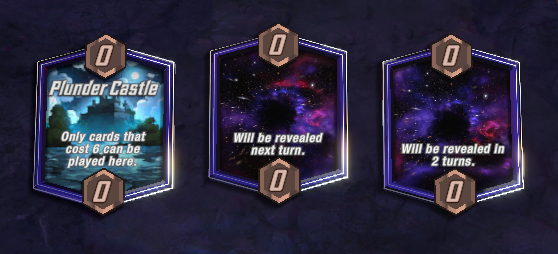The Turns - Opening, Midgame & Endgame
From start to finish, turn by turn.
Opening
Your first two turns are for gathering information, identifying favorable locations, and planning your initial line.
Many players rush through these first turns. Take your time to evaluate the locations and decide which are best for investing power. Come up with a plan before ending your turn.
Consider not playing on these first turns. Your cheap cards may work better as part of a combo, on a different location, or as a response to your opponent’s plays. Many pros will wait until turn 3 before playing anything as a rule, because insight into the locations and your opponent can completely change your best line.
Turn 1
Look at the first location. Is this a good or bad location for you?

Look at your opening hand. What’s the best line, given the cards in your hand?
Some 1-cost cards, like Iceman, grant good early value and are relatively disposable. Others, like Yondu, may support an early line. But be careful with cards like Zero or Nova, which may be more valuable on later turns.
Turn 2
Look at the second location, and the card you just drew. Does this change your line?
Did your opponent play anything? Does this give you any insight into their deck?
Turn 2 is your first opportunity to develop significant power on a location. You may go for early priority with cards like Lizard, set up a lane with cards like Angela, or start your deck’s line with Bucky Barnes, Kraven, Morbius, etc.
But before you commit a card, consider your line if you waited. In particular, tech cards like Armor often benefit from more information about the final location and your opponent’s deck.
What’s your line? Do you have a path to a win condition?
Midgame
In the midgame, you size up the locations, figure out your best approach, and commit to at least one lane.
Turn 3
On turn 3, you have complete knowledge of the locations, and usually some read on your opponent.
Given your current hand, what do you predict the final state of the board to be? Your line will likely commit you to one or two lanes at this point.
If you have a clear path to a win condition, consider snapping. It’s fine to wait longer, but if your play this turn reveals a dominant advantage, you may want to lock in that second cube first.
There are many possible plays on turn 3. Depending on your deck, your best line might play a 3 cost card, multiple cheaper cards, or nothing at all. But most decks use turn 3 to either develop significant power, set up a combo, or disrupt their opponent.
If you have nothing to play on turn 3, you may find yourself behind the curve for the rest of the game.
Turn 4
Turn 4 is a crucial turn to develop power and set up the end game. Your opponent will be doing the same.
On this turn, you fully commit to one or more lanes. You likely have some idea which lanes your opponent is developing, so check your math before contesting the same lane.
By now, you should have a compelling line for the rest of the game in hand, with a clear vision for the final board. You’ve only got two card draws left, so if your plan involves “draw the perfect card”, you’re probably in trouble.
4-cost cards are particularly strong, and fall into a few main categories:
- Power plays, like Warpath, Namor, Jessica Jones, Rescue, or Strong Guy, which set up 8-10 power in a single lane.
- Value cards, like White Queen, Kazar, Hell Cow, or Rock Slide, which provide decent power alongside a useful effect.
- Combo cards, like Wong and Mister Negative, which enable powerful endgame effects.
Some key tech cards, like Shang Chi and Enchantress, are also 4 cost, although these cards are often played on later terms for maximum effect.
Endgame
The endgame is when plan comes together.
Turn 5
Turn 5 is the start of the end game, and usually the most important turn in the game.
5-cost cards are the centerpiece of most decks, and absolutely crucial to setting up a turn 6 more interesting than just playing Hulk.
These cards include Aero, Sera, Shuri, Leech, Devil Dinosaur, Black Panther, and Professor X, and are usually the winning play when executed well. Most decks include multiple 5 cost cards, to ensure they have a decisive play going into the end game.
It’s possible to go for straight power on turn 5, with cards like Gamora and Iron Man. But this approach requires exceptional turn 6 play to maintain your lead. Some decks opt for cheaper cards on turn 5, like Wave and 2-cost in the Deathwave deck, but generally these are specific combo setups that set up explosive turn 6 plays.
Turn 5 is usually your last chance to snap successfully, as it’s the last point where you retain an element of surprise.
If you’re not well-positioned by turn 5, be ready to retreat.
Turn 6
Turn 6 is when every skill is tested and your line comes together.
On turn 6, you should know exactly what cards your opponent is likely to play. But you should also be ready to face any of the common finishers like Leader, Hulk, Magneto, Infinaut, Doctor Doom, Odin, etc.
Take your time and think through every possible combination. Figure out your best play. If you’ve got a read on your opponent, don’t be afraid to trust your gut.

Retreat is always an option on turn 6. No matter how many cubes you’re committed, you can always lose more. Know when you’re beat. If your line can’t hold up against a decent play by your opponent, you should probably save yourself the cubes.
